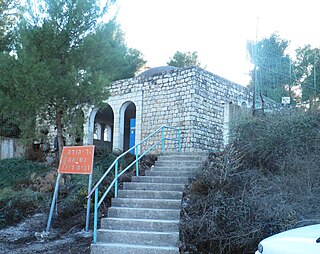Related Research Articles

Judah ha-Nasi or Judah I, was a second-century rabbi and chief redactor and editor of the Mishnah. He lived from approximately 135 to 217 CE. He was a key leader of the Jewish community during the Roman occupation of Judea.
Amoraim refers to Jewish scholars of the period from about 200 to 500 CE, who "said" or "told over" the teachings of the Oral Torah. They were primarily located in Babylonia and the Land of Israel. Their legal discussions and debates were eventually codified in the Gemara. The Amoraim followed the Tannaim in the sequence of ancient Jewish scholars. The Tannaim were direct transmitters of uncodified oral tradition; the Amoraim expounded upon and clarified the oral law after its initial codification.

The Sanhedrin were assemblies of either twenty-three or seventy-one elders, who were appointed to sit as a tribunal in every city in the ancient Land of Israel.
Tannaim were the rabbinic sages whose views are recorded in the Mishnah, from approximately 10–220 CE. The period of the Tannaim, also referred to as the Mishnaic period, lasted about 210 years. It came after the period of the Zugot ("pairs"), and was immediately followed by the period of the Amoraim ("interpreters").

Judah II or Nesi'ah I was a Jewish sage who lived in Tiberias in the Land of Israel, in the middle of the third century CE.
Judah III, Yudan Nesiah, was a prominent Jewish sage, who held the office of Nasi of the ancient Jewish Sanhedrin between about 290 and 320 CE.
Nasi is a Hebrew title meaning "prince" in Biblical Hebrew, "Prince [of the Sanhedrin]" in Mishnaic Hebrew, or "president" in Modern Hebrew.
Simeon ben Gamliel (I) was a Tanna sage and leader of the Jewish people. He served as nasi of the Great Sanhedrin at Jerusalem during the outbreak of the First Jewish–Roman War, succeeding his father in the same office after his father's death in 52 CE and just before the destruction of the Second Temple.
Gamaliel, also spelled Gamliel, is a Hebrew name meaning "God (אל) is my (י-) reward/recompense (גמל)" indicating the loss of one or more earlier children in the family. A number of influential individuals have had the name:
Hanina bar Hama was a Jewish Talmudist, halakhist and aggadist frequently quoted in the Babylonian and the Jerusalem Talmud, and in the Midrashim.
Hoshaiah Rabbah or Hoshayya Rabbah was a Amora of the Land of Israel from the first amoraic generation, compiler of Baraitot explaining the Mishnah-Tosefta.
The Talmudic Academies in Syria Palaestina were yeshivot that served as centers for Jewish scholarship and the development of Jewish law in Syria Palaestina between the destruction of the Second Temple circa 70 CE and the deposition of Raban Gamliel VI circa 425 CE. The academies had a great and lasting impact on the development of world Jewry, including the creation of the Jerusalem Talmud. The region designated as the Land of Israel / Eretz Yisrael in Jewish sources was during the Talmudic period also officially known as Syria Palaestina and Palaestina Prima / Palaestina Secunda.

Abba Saul was a fourth generation Tanna.
Rabbi Ilai was a third Generation, and 2nd-century Jewish Tanna sage, father of the well-known Tanna sage, Judah ben Ilai, and disciple of Eliezer ben Hurcanus and Gamaliel II.
Rabbi Yannai was an amora who lived in the 3rd century, and of the first generation of the Amoraim of the Land of Israel.
Rav Huna Kamma was a rabbi of the 2nd century CE.
Hiyya, or Hiyya the Great, was a Jewish sage in the Land of Israel during the transitional generation between the Tannaic and Amoraic eras. Active in Tiberias, Hiyya was the primary compiler of the Tosefta. His full name is Hiyya bar Abba, also the name of the 3rd generation Amora of the Land of Israel, Hiyya bar Abba. He was a student of Judah haNasi, and uncle and teacher of Rav.
R. Abin (I) was a Jewish Amora sage of the Land of Israel, of the third generation of Amoraim.
Jeremiah bar Abba was a Babylonian rabbi who lived around the mid-3rd century. He is cited many times in the Jerusalem Talmud, where he is mentioned simply as Rav Jeremiah, without his patronymic name.
References
- ↑ Ruth Rabbah 5; Bacher, "Ag. Pal. Amor." iii. 312
![]() This article incorporates text from a publication now in the public domain : Singer, Isidore; et al., eds. (1901–1906). "Judah IV". The Jewish Encyclopedia . New York: Funk & Wagnalls.
This article incorporates text from a publication now in the public domain : Singer, Isidore; et al., eds. (1901–1906). "Judah IV". The Jewish Encyclopedia . New York: Funk & Wagnalls.
| Preceded by Gamaliel V | Nasi 385–400 | Succeeded by Gamaliel VI |